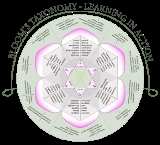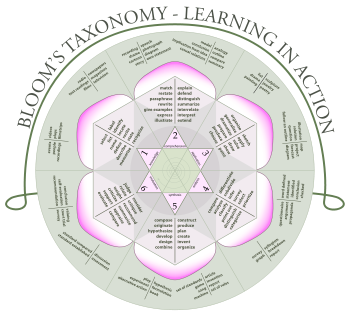
Benjamin Bloom
Encyclopedia
Benjamin Samuel Bloom was an American
educational psychologist
who made contributions to the classification of educational objectives and to the theory of mastery-learning
. He also directed a research team which conducted a major investigation into the development of exceptional talent whose results are relevant to the question of eminence, exceptional achievement, and greatness
.
. From the Pennsylvania State University
, he gained his bachelor’s and master’s degrees in 1935. Later, in March 1942, he received his education Ph.D. from the University of Chicago
. Bloom died on September 13, 1999.
, which shows an astonishing positive effect for the average student in conditions of one-to-one tutoring using Mastery learning
techniques. Bloom realized one-to-one tutoring is impossible for most societies, and thus encouraged educators to study combinations of other alterable variables in the learning process that may approach the 2 sigma results.
He focused much of his research on the study of educational objectives and, ultimately, proposed that any given task favors one of three psychological domains: cognitive, affective, or psychomotor
. The cognitive domain deals with a person's ability to process and utilize (as a measure) information in a meaningful way. The affective domain relates to the attitude
s and feeling
s that result from the learning
process. Lastly, the psychomotor domain involves manipulative or physical skills.
Benjamin Bloom headed a group of cognitive psychologists at the University of Chicago
that developed a taxonomic hierarchy of cognitive-driven behavior deemed important to learning and to measurable capability. (For example, one can measure an objective that begins with the verb "describe", unlike one that begins with the verb "understand".)
 Bloom's classification of educational objectives, Taxonomy of Educational Objectives, Handbook 1: Cognitive Domain (Bloom et al., 1956), addresses the cognitive domain (as opposed to the psychomotor and affective domains) of knowledge
Bloom's classification of educational objectives, Taxonomy of Educational Objectives, Handbook 1: Cognitive Domain (Bloom et al., 1956), addresses the cognitive domain (as opposed to the psychomotor and affective domains) of knowledge
. Bloom’s taxonomy provides a structure in which to categorize instructional
objectives and instructional assessment. He designed the taxonomy in order to help teachers and instructional designers to classify instructional objectives and goals
. The taxonomy relies on the idea that not all learning objectives and outcomes have equal merit. In the absence of a classification system (a taxonomy), teachers and instructional designers may choose, for example, to emphasize memorization of facts (which makes for easier testing) rather than emphasizing other (and likely more important) learned capabilities.
Bloom’s taxonomy in theory helps teachers better prepare objectives and, from there, derive appropriate measures of learned capability and higher order thinking skills
. Curriculum
-design, usually a state (governmental) practice, did not reflect the intent of such a taxonomy until the late 1990s. Note that Bloom, as an American academic, lacks universal approval of his constructs.
The curriculum of the Canadian Province of Ontario
offers a good example of the application of a taxonomy of educational objectives: it provides for its teachers an integrated adaptation of Bloom's taxonomy. Ontario's Ministry of Education
specifies as its taxonomic categories: Knowledge and Understanding; Thinking; Communication; Application. Teachers can classify every 'specific' learning objective, in any given course, according to the Ministry's taxonomy.
United States
The United States of America is a federal constitutional republic comprising fifty states and a federal district...
educational psychologist
Educational psychology
Educational psychology is the study of how humans learn in educational settings, the effectiveness of educational interventions, the psychology of teaching, and the social psychology of schools as organizations. Educational psychology is concerned with how students learn and develop, often focusing...
who made contributions to the classification of educational objectives and to the theory of mastery-learning
Mastery learning
In Mastery learning, "the students are helped to master each learning unit before proceeding to a more advanced learning task" in contrast to "conventional instruction"....
. He also directed a research team which conducted a major investigation into the development of exceptional talent whose results are relevant to the question of eminence, exceptional achievement, and greatness
Greatness
Since the publication of Francis Galton’s Hereditary Genius in 1869, and especially with the accelerated development of intelligence tests in the early 1900s, there has been a vast amount of social scientific research published relative to the question of ‘greatness’...
.
Biography
Benjamin Samuel Bloom was born on February 21, 1913, in Lansford, PennsylvaniaLansford, Pennsylvania
Lansford is a borough in Carbon County, Pennsylvania, located northwest of Allentown and 9 miles south of Hazleton. Settled in 1845, Lansford was incorporated in 1876. In 1900, 4,888 people lived in Lansford; in 1910, 8,321 people inhabited it, and in 1940, 8,710 residents called Lansford home....
. From the Pennsylvania State University
Pennsylvania State University
The Pennsylvania State University, commonly referred to as Penn State or PSU, is a public research university with campuses and facilities throughout the state of Pennsylvania, United States. Founded in 1855, the university has a threefold mission of teaching, research, and public service...
, he gained his bachelor’s and master’s degrees in 1935. Later, in March 1942, he received his education Ph.D. from the University of Chicago
University of Chicago
The University of Chicago is a private research university in Chicago, Illinois, USA. It was founded by the American Baptist Education Society with a donation from oil magnate and philanthropist John D. Rockefeller and incorporated in 1890...
. Bloom died on September 13, 1999.
Bloom's theories
In 1984 Bloom published "The 2 Sigma Problem: The Search for Methods of Group Instruction as Effective as One-to-One Tutoring" in the journal Educational Researcher. This paper reported on what has come to be known as Bloom's 2 Sigma ProblemBloom's 2 Sigma Problem
Bloom's 2 sigma problem refers to an educational phenomenon observed by educational psychologist Benjamin Bloom and initially reported in 1984 in the journal "Educational Researcher"...
, which shows an astonishing positive effect for the average student in conditions of one-to-one tutoring using Mastery learning
Mastery learning
In Mastery learning, "the students are helped to master each learning unit before proceeding to a more advanced learning task" in contrast to "conventional instruction"....
techniques. Bloom realized one-to-one tutoring is impossible for most societies, and thus encouraged educators to study combinations of other alterable variables in the learning process that may approach the 2 sigma results.
He focused much of his research on the study of educational objectives and, ultimately, proposed that any given task favors one of three psychological domains: cognitive, affective, or psychomotor
Psychomotor learning
Psychomotor learning is the relationship between cognitive functions and physical movement. Psychomotor learning is demonstrated by physical skills such as movement, coordination, manipulation, dexterity, grace, strength, speed; actions which...
. The cognitive domain deals with a person's ability to process and utilize (as a measure) information in a meaningful way. The affective domain relates to the attitude
Attitude (psychology)
An attitude is a hypothetical construct that represents an individual's degree of like or dislike for something. Attitudes are generally positive or negative views of a person, place, thing, or event— this is often referred to as the attitude object...
s and feeling
Feeling
Feeling is the nominalization of the verb to feel. The word was first used in the English language to describe the physical sensation of touch through either experience or perception. The word is also used to describe experiences, other than the physical sensation of touch, such as "a feeling of...
s that result from the learning
Learning
Learning is acquiring new or modifying existing knowledge, behaviors, skills, values, or preferences and may involve synthesizing different types of information. The ability to learn is possessed by humans, animals and some machines. Progress over time tends to follow learning curves.Human learning...
process. Lastly, the psychomotor domain involves manipulative or physical skills.
Benjamin Bloom headed a group of cognitive psychologists at the University of Chicago
University of Chicago
The University of Chicago is a private research university in Chicago, Illinois, USA. It was founded by the American Baptist Education Society with a donation from oil magnate and philanthropist John D. Rockefeller and incorporated in 1890...
that developed a taxonomic hierarchy of cognitive-driven behavior deemed important to learning and to measurable capability. (For example, one can measure an objective that begins with the verb "describe", unlike one that begins with the verb "understand".)

Knowledge
Knowledge is a familiarity with someone or something unknown, which can include information, facts, descriptions, or skills acquired through experience or education. It can refer to the theoretical or practical understanding of a subject...
. Bloom’s taxonomy provides a structure in which to categorize instructional
Education
Education in its broadest, general sense is the means through which the aims and habits of a group of people lives on from one generation to the next. Generally, it occurs through any experience that has a formative effect on the way one thinks, feels, or acts...
objectives and instructional assessment. He designed the taxonomy in order to help teachers and instructional designers to classify instructional objectives and goals
Goal
A goal is an objective, or a projected computation of affairs, that a person or a system plans or intends to achieve.Goal, GOAL or G.O.A.L may also refer to:Sport...
. The taxonomy relies on the idea that not all learning objectives and outcomes have equal merit. In the absence of a classification system (a taxonomy), teachers and instructional designers may choose, for example, to emphasize memorization of facts (which makes for easier testing) rather than emphasizing other (and likely more important) learned capabilities.
Bloom’s taxonomy in theory helps teachers better prepare objectives and, from there, derive appropriate measures of learned capability and higher order thinking skills
Higher order thinking skills
The concept of higher order thinking skills became a major educational agenda item with the 1956 publication of Bloom's taxonomy of educational objectives....
. Curriculum
Curriculum
See also Syllabus.In formal education, a curriculum is the set of courses, and their content, offered at a school or university. As an idea, curriculum stems from the Latin word for race course, referring to the course of deeds and experiences through which children grow to become mature adults...
-design, usually a state (governmental) practice, did not reflect the intent of such a taxonomy until the late 1990s. Note that Bloom, as an American academic, lacks universal approval of his constructs.
The curriculum of the Canadian Province of Ontario
Ontario
Ontario is a province of Canada, located in east-central Canada. It is Canada's most populous province and second largest in total area. It is home to the nation's most populous city, Toronto, and the nation's capital, Ottawa....
offers a good example of the application of a taxonomy of educational objectives: it provides for its teachers an integrated adaptation of Bloom's taxonomy. Ontario's Ministry of Education
Ministry of Education (Ontario)
The Ministry of Education is the agency of the Ontario government in the Canadian province of Ontario responsible for government policy, funding, curriculum planning and direction in all levels of public education, including elementary and secondary schools.This Ministry is responsible for...
specifies as its taxonomic categories: Knowledge and Understanding; Thinking; Communication; Application. Teachers can classify every 'specific' learning objective, in any given course, according to the Ministry's taxonomy.
Further reading
- Bloom, Benjamin S. (1980). All Our Children Learning. New York: McGraw-Hill.
- Bloom, Benjamin S. Taxonomy of Educational Objectives (1956). Published by Allyn and Bacon, Boston, MA. Copyright (c) 1984 by Pearson Education.
- Bloom, B. S. (ed). (1985). Developing Talent in Young People. New York: Ballentine Books.
- Eisner, Eliot W. "Benjamin Bloom: 1913-1999." Prospects, the quarterly review of comparative education (Paris, UNESCO: International Bureau of Education), vol. XXX, no. 3, September 2000. Retrieved from http://www.ibe.unesco.org/publications/ThinkersPdf/bloome.pdf on April 10, 2009.

